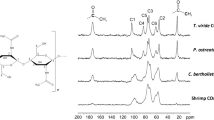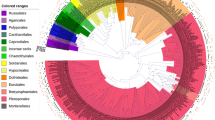Abstract
The symbiotic relationship between termites and Termitomyces fungi, which allows the termite to digest cellulose-rich food sources, is poorly understood. In this study, in vitro mixed symbiotic relationships between Termitomyces clypeatus and fungi isolated from individual fungus-comb communities using a culture-dependent method were analyzed. Twenty-day-old stalk cultures of three T. clypeatus isolates were co-cultured with cellulase-producing fungi on potato dextrose agar. The high cellulase-producing fungal isolate no. 18, which showed 99 % ITS sequence identity to Sordariomycetes endophyte isolate 2171 (EU687039), increased growth of T. clypeatus 18/50 by 85.7 %. The high xylanase-producing isolate no. 13, which showed 88 % ITS sequence identity to Arthrinium sacchari isolate L06 (HQ115662), stimulated T. clypeatus 18/50 growth by 58.6 %. The high cellulase- and xylanase-producing isolate no. 50, which showed 90 % ITS sequence identity to the fungal endophyte isolate 2196 (EU687056), improved T. clypeatus 18/50 growth by 45.7 %. A Gigantropanus sp. promoted the growth of T. clypeatus 18/50 and 20/50 by 45.7 and 44.1 %, respectively, and that of T. clypeatus 19/50 by 10.6 %. These results indicated the most beneficial potential partnership of T. clypeatus might involve cellulase-producing fungi isolated from the same ecological niche. The Gigantropanus sp. is a potential partner of T. clypeatus but is likely to be less common than cellulase-producing fungi isolated from fungus combs owing to the lower host specificity of the Gigantropanus sp. This study provides an interesting method to culture Termitomyces using an in vitro mixed culture method for production of Termitomyces fruiting bodies in the future.




Similar content being viewed by others
References
Ahmad M (1965) Termites (Isoptera) of Thailand. Bull Am Mus Nat Hist 131:1–111
Bignell DE (2000) Symbiosis with fungi. In: Abe T, Bignell DE, Higashi M (eds) Termites: evolution, sociality, symbiosis, ecology. Kluwer Academic Publishers, Holland, pp 289–306
Camp HJMO, Stumm CK, Straatsma G, Derikx PJL, Griensven LJLD (1990) Hyphal and mycelium interactions between Agaricus bisporus and Scytalidium thermophilum on ager media. Microb Ecol 19:303–309
Chen AW, Huang NL (2000) Mixed-culture cultivation of Tremella fuciformis on synthetic logs. The Mushroom Growers’ Newsletter
Cohen R, Persky L, Hadar Y (2002) Biotechnological applications and potential of wood-degrading mushrooms of the genus Pleurotus. Appl Microbiol Biotechnol 58:582–594
Collins N (1981) Populations, age structure and survivorship of colonies of Macrotermes bellicosus (Isoptera: Macrotermitinae). J Anim Ecol 50:293–311
Darlington JECP (1994) Nutrition and evolution in fungus-growing termites. In: Hunt JH, Nalepa CA (eds) Nourishment and evolution in insect societies. Westview Press, Boulder, CO, pp 105–130
Domsch KH, Gams W, Anderson TH (1980) Compendium of soil fungi. Academic Press, London
Guedegbe H, Miambi E, Pando A, Roman J, Houngnandan P, Rouland CL (2009) Occurrence of fungi in combs of fungus-growing termites (Isoptera: Termitidae, Macrotermitinae). Mycol Res 113:1039–1045
Hall T (1999) Bioedit: a user-friendly biological sequence alignment editor and analysis program for Windows 95/98/NT. Nucleic Acids Symp Ser 41:95–98
Heim R (1977) Termites et Champignons. Société Nouvelle Des Ėditions Boubéé, Paris
Hyodo F, Inoue T, Azuma JI, Tayasu I, Abe T (2000) Role of the mutualistic fungus in lignin degradation in the fungus-growing termite Macrotermes gilvus (Isoptera; Macrotermitinae). Soil Biol Biochem 32(5):653–658
Hyodo F, Tayasu I, Inoue T, Azuma JI, Kudo T, Abe T (2003) Differential role of symbiotic fungi in lignin degradation and food provision for fungus-growing termites (Macrotermitinae: Isoptera). Funct Ecol 17(2):186–193
Johjima T, Ohkuma M, Kudo T (2003) Isolation and cDNA cloning of novel hydrogen peroxide-dependent phenol oxidase from the basidiomycete Termitomyces albuminosus. Appl Microbiol Biotechnol 61(3):220–225. doi:10.1007/s00253-003-1236-4
Johjima T, Taprab Y, Noparatnaraporn N, Kudo T, Ohkuma M (2006) Large-scale identification of transcripts expressed in a symbiotic fungus (Termitomyces) during plant biomass degradation. Appl Microbiol Biotechnol 73(1):195–203. doi:10.1007/s00253-006-0570-8
Jouquet P, Barré P, Lepage M, Velde B (2005) Impact of subterranean fungus-growing termites (Isoptera, Macrotermitiane) on chosen soil properties in a West African savanna. Biol Fertil Soils 41:365–370
Lee SB, Taylor JW (1990) Isolation of DNA from fungal mycelia and single spores. In: Innis M, Gelfand DH, Sninsky JJ, White TJ (eds) PCR protocols: a guide to methods and applications. Academic Press, San Diego, pp 282–287
Martin MM, Martin JS (1977) Cellulose digestion in the midgut of the fungus-growing termite Macrotermes natalensis: the role of acquired digestive enzymes. Science 199:1453–1455
Martin KJ, Rygiewicz PT (2005) Fungal-specific PCR primers developed for analysis of the ITS region of environmental DNA extracts. BMC Microbiol 5(1):28. doi:10.1186/1471-2180-5-28
Matoub M, Rouland C (1995) Purification and properties of the xylanases from the termite Macrotermes bellicosus and its symbiotic fungus Termitomyces sp. Comp Biochem Physiol, B: Comp Biochem 112(4):629–635
Matsumoto T (1976) The role of termites in an equatorial rain forest ecosystem of West Malaysia. Oecologia 22:153–178
Moriya S, Inoue T, Ohkuma M, Yaovapa T, Johjima T, Suwanarit P, Sangwanit U, Vongkaluang C, Noparatnaraporn N, Kudo T (2005) Fungal community analysis of fungus gardens in termite nests. Microbes Environ 20(4):243–252
Murashima K, Doi RH (2003) Selection of heat-stable Clostridium cellulovorans cellulases after in vitro recombination. In: Arnold FH, Georgiou G (eds) Methods in molecular biology. Humana Press Inc., Totowa, NJ
Ohga S, Royse DJ (2001) Transcriptional regulation of laccase and cellulase genes during growth and fruiting of Lentinula edodes on supplemented sawdust. FEMS Microbiol Lett 201(1):111–115
Ohkuma M (2003) Termite symbiotic systems: efficient bio-recycling of lignocellulose. Appl Microbiol Biotechnol 61:1–9. doi:10.1007/s00374-005-0839-6
Pegler DN, Vanhaecke M (1994) Termitomyces of south-east Asia. Kew Bull 49:717–736
Rouland C, Lenoir F, Lepage M (1991) The role of the symbiotic fungus in the digestive metabolism of several species of fungus-growing termites. Comp Biochem Physiol A Physiol 99(4):657–663
Rouland-Lefèvre C, Civas A, Renoux J, Petek F (1988) Purification and properties of cellulases from the termite Macrotermes mulleri (Termitidae, Macrotermitinae) and its symbiotic fungus Termitomyces sp. Comp Biochem Physiol, B: Comp Biochem 91(3):449–458
Rouland-Lefèvre C, Inoue T, Johjima T (2006) Termitomyces/termite interactions. In: König H, Varma A (eds) Intestinal microorganisms of termites and other invertebrates. Soil biology, vol 6. Springer, Berlin and New York, pp 335–350
Taprab Y, Ohkuma M, Johjima T, Maeda Y, Moriya S, Inoue T, Suwanarit P, Noparatnaraporn N, Kudo T (2002) Molecular phylogeny of symbiotic basidiomycetes of fungus-growing termites in Thailand and their relationship with the host. Biosci Biotechnol Biochem 66(5):1159–1163
Taprab Y, Johjima T, Maeda Y, Moriya S, Trakulnaleamsai S, Noparatnaraporn N, Ohkuma M, Kudo T (2005) Symbiotic fungi produce laccases potentially involved in phenol degradation in fungus combs of fungus-growing termites in Thailand. Appl Environ Microbiol 71(12):7696–7704
Veivers PC, MÜhlemann R, Slaytor M, Leuthold RH, Bignell DE (1991) Digestion, diet and polyethism in two fungus-growing termites: Macrotermes subhyalinus Rambur and M. michaelseni Sjøstedt. J Insect Physiol 37(9):675–682
Visser AA, Kooija PW, Debetsa AJM, Kuyper TW, Aanena DK (2011) Pseudoxylaria as stowaway of the fungus-growing termite nest: Interaction asymmetry between Pseudoxylaria, Termitomyces and free-living relatives. Fungal Ecol 4(5):322–332
Acknowledgments
This study was supported financially by the Biodiversity, Ecology and Conservation of Termitomyces in Thailand Project, Mahidol University, and partially supported by the Center of Excellence on Agricultural Biotechnology, Science and Technology Postgraduate Education and Research Development Office, Office of Higher Education Commission, Ministry of Education and Research Assistant Scholarship, the Faculty of Graduate Studies of Mahidol University.
Author information
Authors and Affiliations
Corresponding author
Rights and permissions
About this article
Cite this article
Sawhasan, P., Worapong, J., Flegel, T.W. et al. Fungal partnerships stimulate growth of Termitomyces clypeatus stalk mycelium in vitro. World J Microbiol Biotechnol 28, 2311–2318 (2012). https://doi.org/10.1007/s11274-012-1038-x
Received:
Accepted:
Published:
Issue Date:
DOI: https://doi.org/10.1007/s11274-012-1038-x




